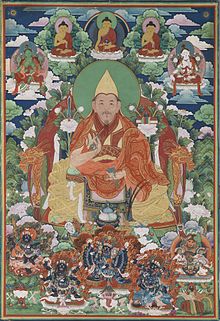Changkya Rölpé Dorjé
Tampilan
Changkya Rölpé Dorjé | |
|---|---|
ལྕང་སྐྱ་རོལ་པའི་རྡོ་རྗེ། | |
 | |
| Informasi pribadi | |
| Lahir | 1717 |
| Meninggal | 1786 |
| Agama | Buddha |
| Mazhab | Buddha Tibet |
| Silsilah | Changkya Khutukhtu |
| Sekte | Gelug |
| Kiprah keagamaan | |
| Reinkarnasi | Changkya Ngawang Losang Chöden |
Changkya Rölpé Dorjé (1717-1786) merupakan guru pembimbing Buddha Tibet di istana Dinasti Qing dan menjadi rekan dekat Kaisar Qianlong Tiongkok sekaligus sebagai perantara penting antara istana kekaisaran dengan Asia Dalam.[1][2] Dia memantau terjemahan Kanon Buddha Tibet ke dalam Bahasa Mongolia Klasik dan Bahasa Manchu. Dia juga terlibat dalam penyusunan satu set caturbahasa (Mandarin, Manchuria, Mongolia dan Tibet) serta mengawasi terjemahan dari aksara Han ke bahasa Manchuria, Mongolia dan Tibet dari seluruh Sūtra Śūraṅgama yang diselesaikan pada 1763, terjemahan dalam bahasa Tibet saat ini disimpan sebagai pelengkap Narthang Kangyur.[3][4][5][6][7]
Referensi
[sunting | sunting sumber]- ^ Samuel, Geoffrey (2012). Introducing Tibetan Buddhism. Introducing World Religions. Abingdon: Routledge. hlm. 249. ISBN 978-0-415-45664-7.
- ^ "Changkya Rolpé Dorje". Rigpa Wiki. Rigpa. Diakses tanggal 2014-07-16.
- ^ von Staël–Holstein, Baron A. (April 1936). "The Emperor Ch'ien-Lung and the Larger Śūraṃgama Sūtra". Harvard Journal of Asiatic Studies. 1 (1): 145.
The translation of the sutra were begun in A.D. 1752 and finished in A.D. 1763.
- ^ Chai Bing (柴冰) (March 2014). "Qián lóng huáng dì 《 yù zhì léng yán jīng xù 》 mǎn、hàn wén běn duì kān jí yán jiū" 内蒙古大学学报(哲学社会科学版)-乾隆皇帝《御制楞严经序》满、汉文本对勘及研究 [Journal of Inner Mongolia University (Philosophy and Social Sciences)- The Qianlong Emperor's "Foreword to The Royal Translation and Compilation of the Śūraṅgama Sūtra" : Research and Comparison of the Manchu Language and Chinese Text]. DOC88.COM. Vol. 46 No. 2 (dalam bahasa Chinese). hlm. 88. Diakses tanggal 2017-12-06.
乾隆皇帝在位时间,曾将其译成藏、满、蒙、汉文四体合璧本。(tr. into English : During the reign of the Qianlong Emperor, the Emperor ordered the translation of the Śūraṅgama Sūtra into Tibetan, Manchu language and Mongolian and combined with the Chinese into a four language compilation.
- ^ von Staël–Holstein, Baron A. (April 1936). "The Emperor Ch'ien-Lung and the Larger Śūraṃgama Sūtra". Harvard Journal of Asiatic Studies. 1 (1): 145.
Whenever there was the possibility of a doubt [the correct translation] was quickly fixed by advice from the state teacher (or National Preceptor) [8b] Lcan-skya Hu-thog-thu (also known as the Third Changkya Khutukhtu Rölpé Dorjé) and [the question] settled.
- ^ von Staël–Holstein, Baron A. (April 1936). "The Emperor Ch'ien-Lung and the Larger Śūraṃgama Sūtra". Harvard Journal of Asiatic Studies. 1 (1): 146.
cf. Footnote 30: (volume KI of the Mdo division of the Narthang Kanjur is of course printed in black letters.) – the Tibetan version of my xylograph seems to be identical with the Tibetan version of the quadralingual edition.
- ^ Even though von Staël–Holstein call this tripitaka the Narthang Kanjur, I believed it is known as the Peking (Beijing) Kangyur in today’s usage. The early print editions of the Peking Kangyur were printed in vermilion ink. Later printings and any supplements would have been printed in black ink. Cf. von Staël–Holstein, Baron A. (April 1936). "The Emperor Ch'ien-Lung and the Larger Śūraṃgama Sūtra". Harvard Journal of Asiatic Studies. 1 (1): 146.
Prince Fu-ch’üan, the chief editor of the A.D. 1700 Kanjur edition, reports that in preparing the edition, he acted on orders from the emperor K’ang-hsi to complement 補 the Kanjur. The emperor Ch’ien-lung venerated the emperor K’ang-hsi as a model ruler, and followed his grandfather’s example whenever possible.
